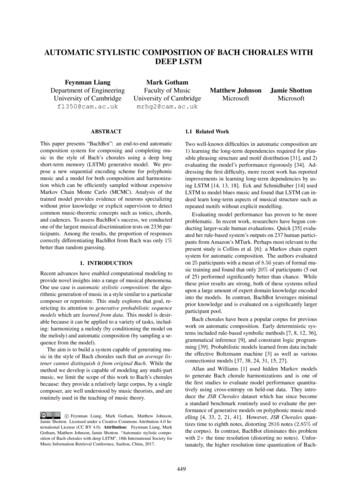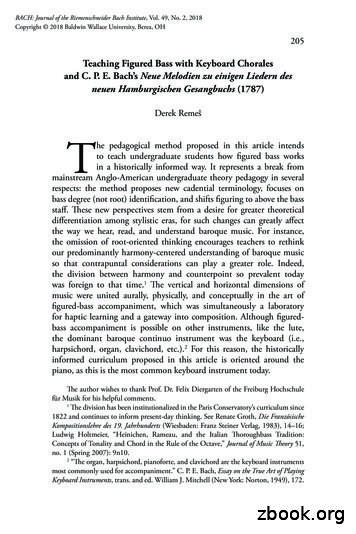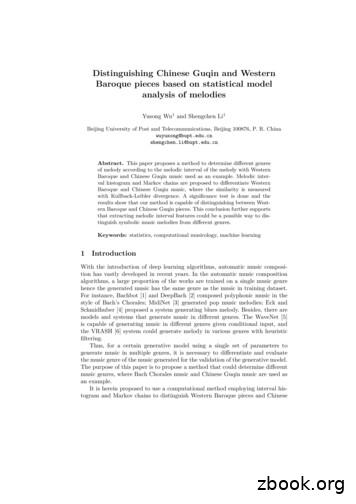Clustering Bach Chorales: Insights Into SATB And Bach’s Style
Clustering Bach Chorales:Insights into SATB and Bach’s StyleDiego Hernandez, Hope Casey-Allen, Jian Yang LumStanford University, California, United States1Introduction and Literature ReviewFew composers have been as influential in the Western musical tradition as Johann Sebastian Bach (16851750), whose four-part chorales for soprano, alto, tenor, and bass (abbreviated SATB, and listed in orderfrom highest to lowest) have become well-known distillations of important music-theoretical principles. Suchprinciples, dealing with both the construction of individual parts and the interactions between those parts,came to dominate Western music for about 150 years after Bach’s time and continue to inform musicalunderstanding today.Some research in machine learning has been devoted to computerized harmonizations (i.e., given a sopranomelody, generate the other three voices in Bach’s style). However, previous projects have encounteredobstacles in their work due to a lack of rigorous understanding of the nuances in Bach’s style. For instance,Allan and Williams (2005) attempted to generate chorale harmonizations in Bach’s style using a HiddenMarkov Model. The results were suboptimal: although the relationships between voices in the resultingchorales were consistent with harmonic rules seen in textbooks, the individual voices themselves sometimeserratically jumped in pitch instead of flowing in natural, intentional contours.It is clear that research is needed to more precisely characterize SATB voices in Bach chorales, the insightsfrom which would not only improve algorithms that seek to generate harmonizations but would be useful tomusical theorists and performers in understanding and interpreting music.Our first goal is thus to determine features (independent of relative positions) that distinguish individual SATB voices in Bach chorales. Our second goal is to find and interpret clusterings of chorales thatmay be artistically useful (e.g., helpful in identifying musically similar chorales for purposes of inspiration,comparison, etc.)We have 2 inputs, corresponding to the different goals: inputs for the first goal are the features from thevoice parts of these chorales, looking at 183 4 SATB parts in total. We used k-means clustering, with k 4, in an attempt to yield clusters that divide the voices into their natural SATB taxonomies, revealing thedefining characteristics of each melody; and softmax / multinomial regression for voice prediction, where theoutput is one of the possible SATB values.The inputs to our second goal are features we extracted from the scores of 183 of Bach’s chorales. Weused the elbow method to determine that k 4 for k-means clustering on this input, and outputted distinctclusters for the chorales which reveal insights into Bachs style; and we used EM in an attempt to revealtraits of Bachs style as well.We believe our task has never been attempted in the literature. The closest task we could find to ours is in[3], in which Quinn and Mavromatis clustered every chord transition in a combined corpus of chorales of twocategories: chorales by Bach and modal chorales from about a century before Bach. They then compared eachchorale category’s coverage of each cluster as a means of identifying distinguishing harmonic characteristicsof each category. Although this research provides a window into the overall harmonic landscape of Bach’schorales, it says nothing about the characteristics of SATB voices.1
2Dataset and FeaturesOur dataset contains 183 Bach chorales and 183 4 SATB voice parts, all accessed from “http://kern.humdrum.org/cgi-bin/ksdata?l musedata/bach/chorales&file chor-01.krn&f musedata“ where 01 is thenumber of the chorale. The dataset is encoded in the Humdrum **kern data format; Humdrum was developedby CCARH (Center for Computer Assisted Research in the Humanities) at CCRMA (within Stanford).(a) Sample of a Bach Chorale opening. S is the topline, A the second highest, T the third, B the lowest.(b) The same score, translated into **kernAs seen above, musical information (pitches, metronome markings, measures, metadata, etc) is encoded torepresent a full musical score: We used a toolkit developed by MIT called Music21 to separate the choralesinto parts and extract their features. We categorized relevant features into 9 buckets. For some buckets withmultiple features, we used PCA and extracted the principal component (which for all cases explained at least96% of variation), while for others we added or subtracted the feature values. Normalization was performedon all variables to have mean 0 and variance 1, to aid k-means clustering by assigning equal importance toeach predictor/variable.3MethodsThe two goals we tried to achieve required two different approaches each; determining the differencebetween individual voices is fundamentally a classification problem, while attempting to observe similaritiesbehind chorales that do not have an observable grouping is an unsupervised problem. To that extent, weemployed a mixture of parametric and nonparametric methods for differentiating SATB voices (namely,softmax/multinomial logistic regression, and k-means clustering) and multiple unsupervised methods (kmeans and EM) for clustering chorales.The softmax, or multinomial regression model, posits k (in this case, 4, one corresponding to one voicetype) different outcomes/voice types, with total probability summing to one (with a constraint on the lastvariable). Maximization of the log-likelihood of the model:mXi 1lnkYl 1Teθ lTPkj 1!1{y(i) l}x(i)eθ j x(i)was done using a single-hidden-layer neural network, in which a (hidden) layer of variables is estimatedusing a vector of weights w with w nk (n being number of features, k 4). The neural net thenused backpropagation of errors to the inputs with gradient descent to update the parameters returned. Thesoftmax model was chosen as it did not require breaking down into binary classification problems.k-means clustering iteratively seeksPto find the cluster centroids that minimize the aggregate residual summof squares of all points in that cluster, i 1 x(i) µc( i) 2 , by first reassigning both the assignments of eachpoints to the nearest centroid, then moving that centroid to the mean of all points with that same assignment.k-means was used as an exploratory data analysis mechanism, as well as understanding properties of eachgroup by exploring properties behind its centroids.2
The EM algorithm, used when a latent random variable is suspected (in this case, the different stylesBach may have used), performs maximum likelihood estimation in a two-step mechanism: it first constructsa lower-bound on the likelihood via Jensen’s inequality (by equating the new distribution of the latentvariables to be the posterior distribution of the latent variables given the observed variables and the currentparameters) (E-step), then optimizes it (by maximizing the lower-bound of the likelihood with respect to theparameters) (M-step). It was another option over the k-means algorithm, in that it allowed us to observepotential distribution properties of the latent variables, besides looking at centroids. All data analysis wasdone in R, with packages nnet and mclust for softmax and EM respectively.44.1Results and DiscussionIndividual Voice Clustering/ClassificationFor clustering, besides attempting to lower the misclassification rate, we hoped to identify variables ofinterest that strongly influence the classification of voice lines into their voice types, as the goal was to studythe properties of different melodic lines.The k-means approach (k 4, corresponding to SATB voices) yielded a misclassification rate of 32.1%,with most errors misidentifying the SAT voices (only 6% involving both Type I or II errors involving thebass line); this implies that the bass line is most distinct, followed by the soprano line.Table 1: K-means cluster results versus actual voice 78(a) Cluster Results, plotted against first two principalcomponents.The softmax approach had a 10-fold cross-validation error of 25.5%. With the dataset, the p-values werecalculated for each estimator using the test statistic of Z E(θi ) ; only the p-values that were statisticallyVar(θi )significant (i.e. p-value less than 0.05, for the null hypothesis that θi 0) were considered for analysis.As an entire predictor, only averageMelodicInterval and rangeIndivVoices were statistically significant for all three voice types (one of the four categories, the bass, was arbitrarily used as the baseline, henceonly three predictors were needed). For both predictors, the bass had the highest average melodic intervaland the largest range of individual voices, agreeing with music-theoretical approaches of wide movements inthe bass line. Amongst other variables that were statistically significant, the alto and tenor both showedincreased percentages of repeated notes, the soprano generally had faster melodic tempi and a lot more3
diatonic movement (as opposed to chromatic movement). For all data, duration of melodic intervals was nota useful predictor.4.2Chorale clustering: Unsupervised LearningIn picking the appropriate k to use for the initial k-means exploration, we elected to use the elbow method(b), a visual inspection method that attempts to find the maximum number of k for which the improvementsby adding one more are minimal (in this case, looking at the smallest angle for each point, when plottedagainst residual sum of squares (with respect to centroids)). While there was no clear-cut change in gradient,an observable bend at k 4 was noted, and as such k was initialized to be 4.(b) Elbow Method Plot: RSS against k.We pick the point with sharpest changeof gradient, here 4.(c) Cluster Visualization, plotted onfirst two principal components.The initial round of clustering (c) produced an equal-sized grouping of clusters. Observing the clustercentroids, the key findings were that the four groups had properties corresponding to:1. arpeggiated, repeated notes2. small range3. big melodic interval, few repeated notes4. long melodic arcs, highly consonant, big rangeThe EM algorithm (which proceeded by a Gaussian mixture modelling), by contrast, returned a clusternumber of 2, based off the calculation of the Bayes Information Criterion (BIC), 2 ln(L̂) k ln(n); the lowestBIC for all models returned a model that had an ellipsoidal distribution, had equal volume and orientation,and had 2 clusters.(d) Classification Boundary, 2-cluster model.(e) Biplot of variables, 2-cluster model.However, the EM algorithm has one cluster with only 9% of data points (16), while the other cluster had91% of the data points. Furthermore, a classification decision boundary (on a two-dimensional feature space4
comprising the first two principal components of the data) (d) reveal a circular inner, coupled with an outerand scattered cluster.Similarly, a biplot of all variables (e) do not reveal two distinct cluster groups, while a density model ofboth latent variables (cluster groups) (f) show that both means overlap within a high-density region, hencemaking it hard to separate the clusters into linearly separable groups.(f) Density plots, 2-cluster model.(g) Classification Boundary, 4-cluster model.Another round of EM was conducted, this time with k 4 (in conformance to the elbow result). Theresults were not as clear as that of k-means, featuring a substantial proportion of outliers (g). The findingsof the EM demonstrate that perhaps more variables might be required to make a more conclusive stance oncluster assignments, and that perhaps Bach did not actually have multiple styles used. Furthermore, theEM algorithm’s failure to detect any substantial/clear-cut clustering may have to do with the assumptionrequired that the model was Gaussian; some of the variables (e.g. dissonance) was more likely than notdrawn from either a Bernoulli model or some non-Gaussian distribution.5Conclusions and Future WorkOur first goal, investigating the differences in musical lines through structural elements, proved usefulin constructing a typology of voice type; the conclusions (mostly through softmax), which include basslines having widest jumps and largest range and soprano lines having faster melodic tempi etc, conform totheoretical part-writing rules.However, our second objective - to observe clustering within different Bach chorales - proved mixed; apotential failing of the EM algorithm, as pointed out, could have been the Gaussian assumption, while thek-means centroid analysis could see further research done on it, not only to verify that such groupings exist,but to see how it may have correlated with his other works across time (his cantatas, large-scale masses).It follows that future work would include investigating our second objective even further. We could gatherdata for other composers and run EM/other algorithms to clarify the potential failing of our EM algorithmand see if style differences manifest. We would also perform further contextual analysis by extracting featuresfor date of composition (only available for some pieces). This would enable us to investigate not only ifa composer’s style changed over time, but also how their composition style corresponds to the liturgicalcalendar, which was a major influence for much of western musical tradition. Overall, the insights gleanedfrom more research in this area would shape musicians’ understanding of these pieces and the subtleties thataccompany them.5
References[1] Allan, Moray, and Christopher KI Williams. ”Harmonising chorales by probabilistic inference.” Advances in neural information processing systems 17 (2005): 25-32.[2] Morris, Robert D. ”New directions in the theory and analysis of musical contour.” Music Theory Spectrum 15.2 (1993): 205-228.[3] Quinn, Ian, and Panayotis Mavromatis. ”Voice-Leading Prototypes and Harmonic Function in TwoChorale Corpora.” MCM. 2011.[4] Temperley, David. ”Probabilistic Models of Melodic Interval.” Music Perception: An InterdisciplinaryJournal 32.1 (2014): 85-99.[5] Witten, Ian H., Leonard C. Manzara, and Darrell Conklin. ”Comparing human and computationalmodels of music prediction.” Computer Music Journal (1994): 70-80.6
ual SATB voices in Bach chorales. Our second goal is to nd and interpret clusterings of chorales that may be artistically useful (e.g., helpful in identifying musically similar chorales for purposes of inspiration, comparison, etc.) We have 2 inputs, corresponding to the di erent goals: inputs for the rst goal are the features from the
Bach chorales, from music theorists and theory students interested in studying the Bach chorale style or in using the chorales in the classroom, to musicologists and Bach scholars interested in the most up-to-date research on the chorales, to choral directors and organists interested in performing the chorales, to amateur Bach-lovers alike.File Size: 1MBPage Count: 65
Bach himself. Many of Bach's chorales are harmoniza-tions by Bach of pre-existing melodies (not by Bach) and certain melodies (by Bach or otherwise) form the basis of multiple chorales with different harmonizations. We extend this harmonization task to the completion of chorales for a wider number and type of given parts. Let
THREE BACH CHORALES CHORALES Four-part arrangements with flexible part assignments. Will work with many different sized groups, from quartets to full band. All parts are provided in the form of a single master page. The purchaser is licensed to duplicate parts as required for use in their own program. For Young Bands 19022 - 49A Avenue .
Bach used these four-part chorales in larger works, such as cantatas or oratorios. Today, 371 of these chorale harmonizations still survive. What these chorales have provided for music theorists and historians is a large data-set of music from the Baroque era
Bach’s vocal chorales have had in harmony curricula ever since C. P. E. Bach’s first publication of them in 1765.5 The aim of this article is to take the first steps in developing a curriculum centered around the keyboard chorale that can replace our current focus on Bach’s vocal chorales.
melodies Johann Sebastian Bach usually “went to considerable pains to avoid consecutives”, as Malcolm Boyd argues.iii Given that some successions of this kind do exist in the Bach chorales, though, the goal of our project was to account for all cases of consecutives formed in the chorales
Bach Chorales dataset is a symbolic music dataset formatted in MuiscXML, containing 409 pieces with 7241 measures. Bach Chorales dataset is mostly in four parts harmony, composed of four parts (Soprano, Alto, Tenor, Bass) in each score. In Bach Chorales dataset, some scores have extra accompaniment
Blueprint One marks the start of a transformational next stage of the Future at Lloyd’s. It is the beginning of our plan to create a modern, more relevant Lloyd’s market and, in doing so, lead the insurance industry for the next generation. This blueprint is: Our strategic intent, describing our vision for how the Lloyd’s market of the future will look . Our current thinking on .























